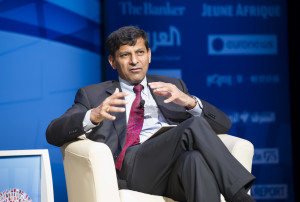
Raghuram Rajan took over as the RBI Governor on 4th September 2013. With a shift in power from Congress to BJP , India saw a change in the ideologies of its representatives. We went on from focusing on expenditure on health and education to promoting investment in institutional areas. Along with this significant development came another major change. The position of the RBI governor switched from D Subbarao to Raghuram Rajan.
He came across as one with unconventional strategies for facilitating growth. Slashing interest rates in an atmosphere of uncertainty at the global level was one such move.
Calling Rajan’s performance over his tenure to be brilliant would be an understatement. He took the position as a Governor during a period when no one would have been willing to accept it ; the Indian economy was in a low growth and high inflation phase , triggered by the global turmoil in 2008. His ‘out of the box’ strategies and provocative action plan helped India recover from the commonly called ‘Great Reversal’ from fortune in 2007 to misfortune in 2008.
Over the last three years , Raghuram Rajan has provided a new dimension to the entire approach of our central bank (RBI) with his global perspective , yet maintaining the unique advantages of Indian economy and ecosystem. He proposed 35 specific reforms that he had written in a report in 2009 as unfinished agendas which lie in the realm of RBI and started checking them off. Some of them included making inflation targeting the predominant function of RBI , open banking to well-governed deposits – taking small finance banks , liberalising business correspondent network and removing restrictions on banks opening branches and ATM. He was reconstituting RBI from within by upgrading skills of officers , making departments and committees specialised in particular tasks , increasing involvement with the youth by encouraging them to do internships with RBI and pressing for performance by keeping deadlines and not accepting anything other than technically correct decisions. The result of many of the new initiatives that he undertook will now depend on how the next governor (Urjit Patel) will deal with the challenges of these ambitious ideas.
His contributions to revive the economy are unparalleled. His work promoted confidence among foreign investors and increased India’s credibility in the global markets. The foreign exchange reserves reached a record high in June 2016 to be at $343.64 billion. He initiated a bank clean up , forcing banks to reveal their non-performing assets , something that had been under cover for years. The losses reported by banks were massive and measures to tackle them included conversion into equity instruments or strategic debt restructuring rules ( banks will now be allowed to convert full or part of the loans held by Corporate borrowers into equity shares of the company ).
Licenses were given to two new banks (IDFC and Bandhan Bank) and bucolic areas saw increased access to financial services. In the context of market development , he introduced term repo operations to infuse liquidity ( term repos are short term repurchase agreement where in banks can borrow from RBI to adjust their short term liquidity needs ). These term repo , conducted for different periods has allowed for better pricing of credit in the market and has led to the development of yield curve.
For the first time , a framework for foreign investor participation in the bond market has also been put in place where foreign investment limit in central government securities is raised to 5% of outstanding stocks of such securities and foreign investors are permitted to hold 2% of state development loans.
Despite all the achievements , he has also been a victim of certain criticisms. His struggle for inflation resulted in him being called the ‘inflation warrior’.
Arguments against him include –
1. Flawed idea to link inflation to domestic excess demand. The reason for inflation is believed to be global excess demand and hence Rajan’s interest rate hike was not reasonable.
2. Delay in recognising the need to make inflation as a predominant goal.
3. After the start of rate cut cycle , he didn’t do enough to help the money markets that were grasping for liquidity.
Rajan’s denial to the second term , what a lot of people call as the ‘Rexit’ has been considered as a loss to the nation and academic’s gain. His announcement to withdraw gave the Indian stock market Monday blues as Sensex fell by 178 points on June 20, 2016 and the rupee slumped.
Urjit Patel , presently one of the four deputy governors at RBI has been appointed as the next RBI governor. Also known as the ‘inflation warrior’ of Rajan , Patel will take charge on September 4 , the day Raghuram Rajan completes his three-year term and steps down.